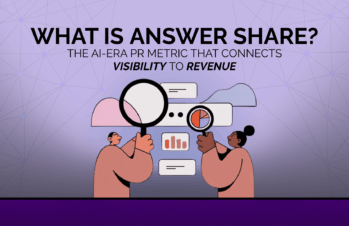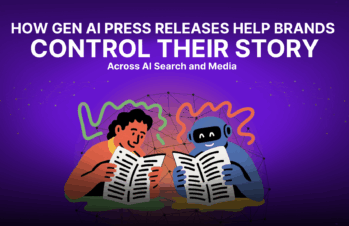We hear a lot about the importance of being “data-driven” in business. But what exactly does that mean in the world of PR? Well, creating a data-driven marketing strategy means two things:
- You use data from previous campaigns to inform your PR strategy.
- You use data to justify your decisions and curate your pitches—media can’t resist a good data-centric story.
Being data-driven doesn’t mean you must become a data scientist. PR professionals from all walks of the industry can learn to gather, interpret, and derive insights from past digital campaigns and analyst studies to help them build more effective campaigns and garner more attention from critical media outlets.
How to use data to build your PR strategy
When you set out to incorporate data into your B2B marketing strategy, you should first look at internal data sets. What information do you already have about your customers that can help you tailor your campaign to reengage those customers, find similar customers, or cross-promote to another customer profile? Then, look at data from previous campaigns. Which platforms saw the most success? Did the people that engaged with your content match your goal target audience? What kinds of outlets were most interested in running with your pitch?
Of course, you can also use third-party data to help build your data-driven marketing strategy, but you’ll need to make sure you’re pitching a unique angle if you aren’t offering new, proprietary data.
Related reading: How to Write a Press Release
How to create data-driven media pitches
PR strategies and marketing tactics almost always include a press release and media pitches of one kind or another. But to qualify these assets as data-driven strategic PR, marketers need to develop them with a data-driven marketing strategy in mind. This means that the media pitch will:
- Lead with the facts.
- Create a compelling story.
- Highlight attention-grabbing stats.
- Zoom in—and zoom out.
- Go beyond the press release.
Lead with the facts and personalize your pitch.
Journalists love data. If you can prove your company had a significant impact on the industry a specific reporter covers or the audience of a specific outlet, reporters will be more inclined to genuinely consider your pitch. At the very least, they’ll finish reading it, which isn’t always the case.
Create a compelling story.
Using stats and data, you can tell a compelling story, but where can you find all of that? Those internal data sets we mentioned above are a great place to start. Journalists don’t want to be sold to. They want to know how you are impacting their audience. So, craft a story that shows what a difference you’ve made—jobs you’ve created, money you’ve donated, community events you’ve sponsored, the environmental impact your new green policy is having on the local river … you get the point.
Highlight attention-grabbing stats.
When you write your media pitch or press release, be sure to include striking stats in the headline, lede, or beginning of the text. Bringing attention to the stat by bolding or underlining it is a simple way to make it stand out.
Zoom in—and zoom out.
Like we’ve said, journalists are looking out for their audience. So, if you are pitching someone with a hyperlocal audience, make your pitch resonate with them. In contrast, you can also make your pitch relevant to broader audiences by connecting to real-world happenings and trending news topics. How can you join a current hot-topic conversation that your prospects are following and engaging in?
Go beyond the press release.
What else can you offer that helps to tell your story? Sure, you’ve prioritized facts and stats and shown your impact on the community, but how can you sweeten the pot? Can you provide case studies, images or graphs, or a compelling reason for the journalists’ audience to want to visit you online? Offer a complementary asset, and the value of your pitch will increase.
Related reading: How to Write a Killer Media Pitch
Benefits of a data-driven PR strategy
There are many clear benefits of a data-driven PR strategy, but a few stand out. If brands invest in cultivating a strategic PR strategy that not only relies on creativity, strong angles, and strategic pitching, but also pulls insights from data, they will be on the fast track to building credibility, strengthening brand visibility, and fortifying industry press relationships.
Build industry authority.
When you base your PR strategy and tactics on data, you build a credible industry reputation. If you regularly supply journalists—and your industry—with updated, reliable data, you will be seen as an authority. Authority builds trustworthiness. And trustworthiness is one of the biggest challenges brands face when trying to convert a prospect.
Gather more internal data.
Having a successful data-driven approach to PR isn’t just about how the PR strategy is executed; it is also about how it is measured. As you develop and pitch stories, you’re creating new data every step of the way. Which outlets seemed more interested in your angle and business? Once you get a few press hits, consider which piece received the most engagement and whether that engagement was largely positive, negative, or a mix. While you might not be able to quantify precisely how many new leads come from each piece of earned media, you can gather crucial information along the way that can help make your internal processes more efficient.
Generate stronger media interest.
We know that marketers can use data to create news hooks that entice journalists to bite. And continually supplying media outlets and your industry with data builds credibility. But these aren’t the only reasons that data-driven strategies generate stronger media interest. Remember that internal data we just talked about? You can use it to segment media. Much like you’d segment customers on an email list (a great tactic for data-driven email marketing), you can segment media, and adapt and personalize pitches for them, increasing the likelihood that they will find value in picking up your story.
Related reading: PR Checklist Proven to Maximize Results
Data-driven strategic planning should be a core part of every brand’s marketing development. When you measure the right metrics and provide value from the insights you discover, your brand builds authority, trust, and more earned media. (And trust us, earned media begets earned media, no matter how niche the outlet or publication may seem.) Want to brainstorm the best way to use data in your next PR campaign? Let’s chat.




